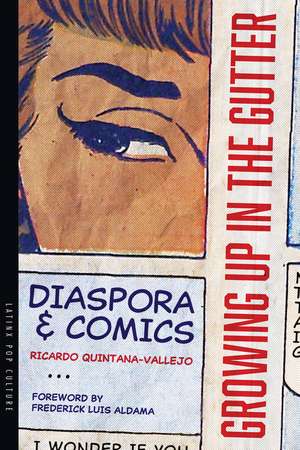Growing Up in the Gutter: Diaspora and Comics: Latinx Pop Culture
Autor Ricardo Quintana-Vallejo Cuvânt înainte de Frederick Luis Aldamaen Limba Engleză Paperback – 28 mai 2024
While the most traditional iteration of the bildungsroman—the coming-of-age story—follows middle-class male heroes who forge their identities in a process of complex introspection, contemporary graphic coming-of-age narratives represent formative processes that fit into, resist, or even disregard narratives of socialization under capitalism, of citizenship, and of nationhood.
Quintana-Vallejo delves into several important themes: how the coming-of-age genre can be used to study adulthood, how displacement and international or global heritage are fundamental experiences, how multidiasporic approaches foreground lived experiences, and how queerness opens narratives of development to the study of adulthood as fundamentally diverse and nonconforming to social norms. Quintana-Vallejo shows how openness enables belonging among chosen families and, perhaps most importantly, freedom to disidentify. And, finally, how contemporary authors writing for the instruction of BIPOC children (and children otherwise affected by diaspora and displacement) use the didactic power of the coming-of-age genre, combined with the hybrid language of graphic narratives, to teach difficult topics in accessible ways.
Preț: 215.07 lei
Nou
Puncte Express: 323
Preț estimativ în valută:
41.15€ • 42.88$ • 34.08£
41.15€ • 42.88$ • 34.08£
Carte disponibilă
Livrare economică 13-27 martie
Livrare express 26 februarie-04 martie pentru 54.39 lei
Preluare comenzi: 021 569.72.76
Specificații
ISBN-13: 9780816553310
ISBN-10: 0816553319
Pagini: 190
Ilustrații: 34 b&w illustrations
Dimensiuni: 152 x 229 x 15 mm
Greutate: 0.3 kg
Editura: University of Arizona Press
Colecția University of Arizona Press
Seria Latinx Pop Culture
ISBN-10: 0816553319
Pagini: 190
Ilustrații: 34 b&w illustrations
Dimensiuni: 152 x 229 x 15 mm
Greutate: 0.3 kg
Editura: University of Arizona Press
Colecția University of Arizona Press
Seria Latinx Pop Culture
Notă biografică
Ricardo Quintana-Vallejo is an assistant professor at Rhode Island College. He is the author of Children of Globalization. He studies migration in narratives about youth development and grew up in Mexico City.
Cuprins
List of Illustrations
Daydreaming New Social Maps with the Global Graphic Bildung: A Foreword by Frederick Luis Aldama
Acknowledgments
Introduction
1. Ghosts and Color: Young Women in Anya’s Ghost, The Best We Could Do, and Juliet Takes a Breath
2. Police Brutality in Black and White: Invisible Boys in I Am Alfonso Jones and Manuelito
3. Queer/LGBTQ+ Coming-of-Age and the Fantastic: Rebellious Identities in You Brought Me the Ocean, The Magic Fish, and The Low, Low Woods
4. Visual and Textual: Hybrid Childhood in Where Are You From?, Eyes That Kiss in the Corners, Areli Is a Dreamer, and My Two Border Towns
Conclusion
Works Cited
Index
Daydreaming New Social Maps with the Global Graphic Bildung: A Foreword by Frederick Luis Aldama
Acknowledgments
Introduction
1. Ghosts and Color: Young Women in Anya’s Ghost, The Best We Could Do, and Juliet Takes a Breath
2. Police Brutality in Black and White: Invisible Boys in I Am Alfonso Jones and Manuelito
3. Queer/LGBTQ+ Coming-of-Age and the Fantastic: Rebellious Identities in You Brought Me the Ocean, The Magic Fish, and The Low, Low Woods
4. Visual and Textual: Hybrid Childhood in Where Are You From?, Eyes That Kiss in the Corners, Areli Is a Dreamer, and My Two Border Towns
Conclusion
Works Cited
Index
Recenzii
“This is a wonderful book about comics, coming-of-age, and racialized identities as they intersect with other aspects of identity such as poverty, refugee status, or LGBTQIA2S+ identities. The author examines how difference enriches and complicates the coming-of-age narrative and how complex the journey to adulthood can be through an examination of a richly diverse group of YA comics.”—Marni Stanley, Vancouver Island University
“Graphic novelists express themselves through textual and visual layout when crafting their narratives, and the gutter is one of the most important tools. Quintana-Vallejo describes gutters in comics as 'the wholly significant white space between panels,' a metaphor that cautions readers not to gloss over topics such as gender, race, class, legal status, and sexuality when engaging with coming-of-age graphic novels.”—R. M. Roberts, CHOICE Connect
“The author stresses the didactic possibilities of coming-of-age graphic narratives, emphasizing the indissolubility of the text-image system to produce meaning in comics; specifically, these texts remind younger audiences that developmental processes do not need to conform to a standardized idea of maturity and, instead, the pathway to a healthy adulthood is marked by tolerance, self-acceptance and cultural hybridity.”—Chiara Simone, Scritture Migranti
“Graphic novelists express themselves through textual and visual layout when crafting their narratives, and the gutter is one of the most important tools. Quintana-Vallejo describes gutters in comics as 'the wholly significant white space between panels,' a metaphor that cautions readers not to gloss over topics such as gender, race, class, legal status, and sexuality when engaging with coming-of-age graphic novels.”—R. M. Roberts, CHOICE Connect
“The author stresses the didactic possibilities of coming-of-age graphic narratives, emphasizing the indissolubility of the text-image system to produce meaning in comics; specifically, these texts remind younger audiences that developmental processes do not need to conform to a standardized idea of maturity and, instead, the pathway to a healthy adulthood is marked by tolerance, self-acceptance and cultural hybridity.”—Chiara Simone, Scritture Migranti
Descriere
Growing Up in the Gutter: Diaspora & Comics is the first book-length exploration of contemporary graphic coming-of-age narratives written in the context of diasporic and immigrant communities in the United States by and for young, BIPOC, LGBTQ+, and diasporic readers. The book analyzes the complex identity formation of first- and subsequent-generation diasporic protagonists in globalized rural and urban environments and dissects the implications that marginalized formative processes have for the genre in its graphic version.







